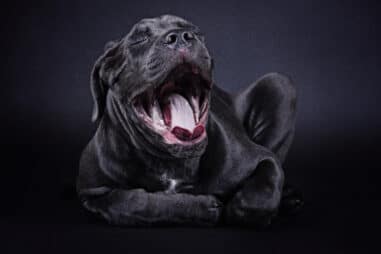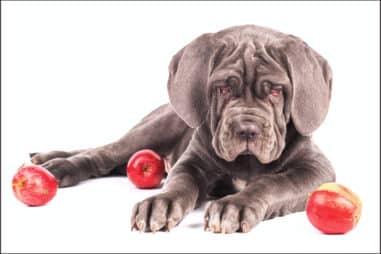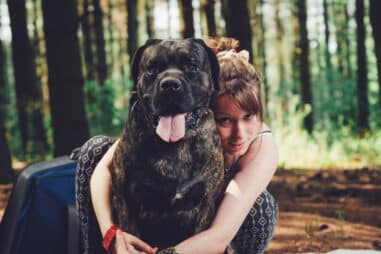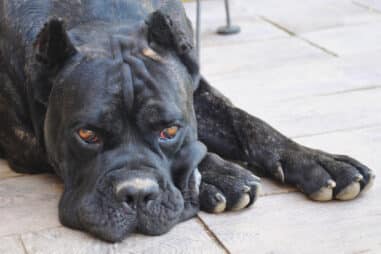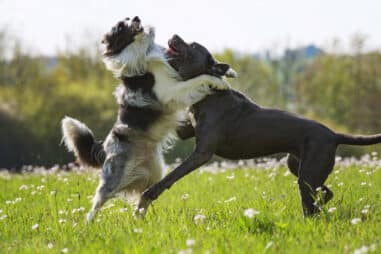The Cane Corso is a large and muscular dog breed that possesses an active and territorial trait. Though it’s a loyal and loving dog, this breed doesn’t easily warm up to strangers and it’s an awesome guard dog. The facial features of a Cane Corso are slightly similar to the face of a Pitbull.
Both dog breeds have short muzzles but Cane Corsos have them longer. They also have looser skin on their faces, and they’re born with long, droopy ears. But it’s not unusual to cross paths with Cane Corsos who have cropped ears.
The most common coat color for this breed is black and 71.6% of their population have this coat color. Some of them also come in brindle, fawn, gray, and red. It’s not instantly obvious but Cane Corsos are double-coated dogs.
They’re mild to moderate shedders, so grooming is not much of a hassle. Before deciding to own one, you need enough space and experience to accommodate their size and temperament. One thing is for sure, Cane Corsos are extremely loyal, so it’s very unlikely for them to leave you hanging.
What Are Cane Corsos?
Cane Corsos are dogs that originated in Italy and they’re also known as Italian Mastiffs. That’s because of their size and place of origin. Unlike the Tibetan Mastiffs, Cane Corsos do indeed belong to the Mastiff breed or family.
Their average height is 23 to 27 inches (584 to 685 mm) and they can weigh 90 to 120 pounds (40.8 to 65.4 kg). They come in different coat colors like black, brindle, fawn, gray and red but the most common is black. Cane Corsos are born with long ears but ear cropping is not uncommon in this breed.
They have double coats that help in regulating their body temperature depending on the weather. Cane Corsos shed their undercoats to get some cool air during a warm season. When the season starts to get cold, the undercoat starts growing back to get more protection and warmth.
Cane Corsos are excellent companions and guards because of their loyal and protective nature. Unfortunately, their size becomes a liability when you have small children and animals at home. They are moderately playful and sociable when backed by training but their urge to protect their turf doesn’t fade.
If you lack experience in dog ownership, a Cane Corso would be too much for you. This breed is not recommended for beginners because of their size and temperament. When proper training or methods are applied, Cane Corsos are capable of being wonderful companions.
What Does the Perfect Cane Corso Look Like?
A pure and perfect Cane Corso stands at about 23 to 27 inches (584 to 685 mm) high. The average weight is somewhere between 90 to 120 pounds (40.8 to 65.4 kg). It’s not very obvious, but a Cane Corso is rocking a double coat that adapts to the changing of temperatures.
The fur strands of their coats are short and coarse, unlike other breeds that have soft and fluffy coats. They’re not heavy shedders so grooming is not a headache. Cane Corsos have a slightly muscular build, and an active lifestyle can enhance it even more.
The natural state of a Cane Corso’s ears is medium in length and is slightly droopy. Cane Corso’s who have short ears usually went through the ear-cropping method. The reason behind the practice is that cropped ears make them less susceptible to infections.
It’s also common for them to have docked tails as it is believed to prevent injuries. Some groups are against the said practices and consider them cruel and unnecessary. Ear cropping and tail docking are not always required for Cane Corsos.
Their natural look is to have medium to long ears and tails. Whichever side you’re on regarding the said methods, it’s best to consult your vet first. Always consider the health and safety of your dog before putting his body through any kind of change.
What Colors Are Cane Corsos?
The colors of Cane Corsos’ coats are black, brindle, fawn, gray, and red. Black and darker shades of gray are the most common coat colors that you’ll see in this breed. Brindle is a color pattern that combines black, brown, or red.
Cane Corsos who have black coats are about 71.6% of their overall population. That’s a huge number so it’s not rare to come across one who’s sporting a black double coat. The shades of their coats are usually darker so pale colors are considered rare.
If you’ve spotted a Cane Corso with a pale-looking coat, it’s a rare one. Most people prefer the dark-coated Cane Corsos because dark shades are natural to this breed. The paler shades are caused by inhibited melanin production and, sometimes, crossbreeding.
Melanin is responsible for the darker shades of a dog’s fur. Black, brindle, fawn, gray, and red are the colors you can expect from a Cane Corso. But black is the most common shade you’ll find when it comes to this breed.
What Is the Most Popular Color of Cane Corsos?
The most popular and preferred coat color in a Cane Corso is black. Owners think that the darker the shade is, the better because dark coats are natural for Cane Corsos. You won’t have a hard time looking for a black-coated Cane Corso because it’s very common.
A large chunk of their population have black double coats. Black Cane Corsos are considered pure, and the ones who are in paler shades probably didn’t produce enough melanin, which is responsible for pigmentation. And paler shades are also possible results of crossbreeding.
The most popular and sought-after coat color is also the most common one. If you’re looking for a black Cane Corso, you won’t have a hard time finding one with that kind of coat. To check the purity of a Cane Corso’s lineage, a breeder can suggest a DNA test.
What Is the Rarest Cane Corso Color?
While black is the most common coat color for Cane Corsos, Beige is the rarest one. In Italy, they’re called Fermentino as they resemble the color of fermented wheat. It’s a pale shade of beige that involves very light shades of brown and gray.
The rare beige coat of a Cane Corso is a possible result of insufficient melanin production. In other mammals including dogs and humans, poor production of melanin can lead to pale skin and hair color. You can safely assume that the beige-colored Cane Corsos are the albinos of their breed.
Cane Corsos who have merle-colored and patterned coats are not purebreds. Merle is a combination of black/brown/red base and lighter shades of blue/gray patches. The combination and pattern give them a unique and interesting look.
As far as purebreds are concerned, beige is the rarest coat color for Cane Corsos. Merle is not a natural color and pattern for their breed’s coat so it doesn’t qualify as standard. DNA tests can reveal the genetic purity of a specific Cane Corso.
What Color Eyes Do Cane Corsos Have?
Based on the standards of the American Kennel Club (AKC), Cane Corsos have two acceptable eye colors. Cane Corsos who have darker muzzles have dark hazel eyes while gray-muzzled ones should have lighter shades. As newborns, Cane Corso puppies have blue eyes but the shade or color will change as they reach adulthood.
If your Cane Corso has red eyes, it’s not normal because red eyes are caused by injuries, infections, and dryness. Prolapse can cause a dog’s eyes to become red, and this condition needs immediate medical attention. Take him to your vet if your Cane Corso’s eyes are red and he’s showing signs of getting uncomfortable.
Do Cane Corsos Have Tails?
Most Cane Corsos in the United States have cropped ears and docked tails but they’re not always required. But in European countries, the practices of ear cropping and tail docking are not allowed. Cane Corsos are born with tails and medium and slightly hanging ears.
The natural and unaltered look of the Cane Corso is different from what you usually see in media. Some people justify the cropping/docking practice because it minimizes the risks of getting injured or infected. But some groups beg to differ because it’s still possible to prevent injuries and infections without cropping/docking.
To some degree, the practices make sense but the decision should depend on your Cane Corso’s lifestyle. Ask for your vet’s opinion and advice regarding cropping/docking. Cane Corsos have tails and you must consider things with seriousness before subjecting your dog to them.
His health and safety must come first at all times. If you think that his tail is not causing any problems, then it’s not mandatory to get his tail docked. Don’t make a decision based on cosmetic reasons; protect him from any unwanted consequences.
Are Cane Corsos Born With Tails?
Cane Corsos are born with tails, and the tail’s length is usually proportionate with their bodies. Their tails are covered with short and coarse fur just like how their bodies are covered with it. The color of the tail matches the color of their double coats.
Some organizations do require tail docking and ear cropping before getting a Cane Corso registered. Cropping/docking are common in the US, but in Europe, the methods of cropping/docking are frowned upon and prohibited. People have varying opinions about the topic and it’s up to you which side you want to be on.
As far as their natural state is concerned, Cane Corsos are meant to have full tails. It’s not uncommon to meet Cane Corsos who had their tails docked to 1/3 of the original length. Docking is usually done early on as puppies have softer tails than adults and that makes cropping easier.
How Long Are Cane Corso Tails?
Even dogs of the same breed can have different tail lengths so it’s a little tricky. Genetics play a big part in this but as an estimate, an adult Cane Corso should have 10 to 12 inches (254 to 304.8 mm) of tail. That is if the dog in question didn’t go through tail docking.
Tail docking in Cane Corsos is a method where the tail is cropped shorter than its original length. This practice is done when a Cane Corso is still a 3 to 5 days old puppy because puppies have softer tails. Docking is considered a risk for adult dogs because they have harder tails.
If a Cane Corso pup is supposed to have a 10 to 12 inches (254 to 304.8 mm) tail as an adult, docking would make it shorter. With tail docking, a pup will have 3.3 to 4 inches (83.8 to 101.6 mm) or even shorter in adulthood. If you’re raising your Cane Corso as a very active dog, tail docking might help in preventing injuries.
Before making a rash decision, ask for a professional’s opinion and advice to avoid irreversible mistakes. At the end of the day, it’s your call but you have to make sure that you’re prioritizing your Cane Corso’s health. Whatever route you’re about to take, always think of your dog’s safety.
Do Cane Corso Tails Curl?
A Cane Corso’s tail is straight and cannot curl or bend like the tails of some dog breeds. This is where the tail docking practice comes into play because a straight and not-so-flexible tail is at risk of getting injured. Owners of Cane Corsos with full tails must observe the safety of their four-legged friends.
Cane Corsos with docked tails are at a lesser risk of getting injured especially when they have a very active lifestyle. Though some groups consider tail docking unnecessary it does have its own merits. The final decision is still up to you, so make sure that your decisions are based on safety and not cosmetic reasons.
A Cane Corso’s tail is not supposed to bend that much or curl, so most of the time, it is straight. Some people will advise you to get your Cane Corso pup’s tail docked while others will express that they’re against it. If you’re not confident, don’t hesitate to ask the pros about it and inform them how you want to raise your pup.
What Do Cane Corso Puppies Look Like?
Cane Corso puppies are pretty much the smaller versions of their parents. Though they would begin with a single coat, Cane Corso puppies will eventually have double coats. Compared to adults, their snouts are rounder and their facial skin is not that loose yet.
If a Cane Corso pup didn’t get its tail docked, you’ll see it wagging about. A Cane Corso’s tail is not very flexible so bending or curling it is dangerous as it can lead to an injury. A puppy’s eye color is blue and it will change gradually in a few months.
At a young age, you can already determine their coat color, and the most common one is black. Some puppies are born with darker coats that get lighter with age and vice versa. Though they can get a few shades lighter/darker, their coats won’t deviate that much from the colors they have as puppies.
During the first month, a Cane Corso’s ears are still intact. Ear cropping is usually done between 8 to 12 weeks, and it’s done a little later than tail docking. Tail docking is performed in the first 5 days of a Cane Corso’s puppy’s life.
Like most puppies, Cane Corso pups have rounder faces and snouts. They’re little, delicate creatures that look like moving plush toys. But as time goes on, these little balls of fur will turn into big dogs that can dwarf the other dogs around them.
How Long Does a Cane Corso Stay a Puppy?
Cane Corso can take a year and a half and sometimes two years before reaching adulthood. Despite their size at about 8 to 12 months, they still have room to grow. Aside from the physical side, they need a couple of years to develop mentally and fully mature.
If you have a Cane Corso who still acts like a pup at 12 months, there’s no need to worry. Some of them take their sweet time before acting like grown-up dogs. So make their younger days fun and interesting by training them early—teach them to socialize and follow routines.
Cane Corsos who are less than 2 years old are, in a way, still puppies. Though it’s hard to believe because of their size, they’re not yet fully developed mentally. If you’re concerned about your pup’s growth and health, visit your vet regularly to tackle the issue as soon as possible.
What Type of Dog Is a Cane Corso?
Cane Corsos belong to the big family of mastiffs, and most mastiff dogs are on the larger side. They’re from a group of working-dog breeds that’s why they desire to get busy. Working-dog breeds are also known as Molossus or Molossian dogs.
The term came from the ancient Greek people called Molosi. This ancient group of people was breeding big dogs that belong to the Mastiff family. Cane Corsos are excellent herders and guards because of their natural tendency to lead and protect.
Though your Cane Corso looks similar to Pitbulls, they’re from different breeds. While he’s from the mastiff group, Pitbulls came from Bulldog and Terrier ancestry. The physical similarities might confuse you, but the most obvious difference is size. Dogs from the Mastiff family are slightly bigger.
What Are the Different Types of Cane Corsos?
Though Cane Corsos belong to only one type of dog breed, some people stand by the idea that there are two types: traditional and nontraditional Cane Corsos. The two groups are separated by minor differences. They may not be officially recognized as separate breeds but some features divide them.
Traditional Cane Corsos are originally from the continent of Europe. They are probably the direct successors of purebred Cane Corso dogs from ages ago because of their features. The traditional Cane Corsos have bigger bones and more prominent teeth that are sometimes comparable to a wolf’s teeth.
Traditional Cane Corsos have slightly longer and coarser coats but crossbreeding is a possible cause. A DNA test is still necessary for the certainty of a specific Cane Corso’s origin or group. The offspring of a Cane Corso and a different breed doesn’t belong to either group.
The next group is the nontraditional Cane Corsos, and most of them had found a home on American soil. They are the ones that went out of Europe and were brought to other parts of the globe. They have shorter coats and less prominent teeth.
Traditional Cane Corsos are more muscular and have primitive behavior like their ancestors. Nontraditional ones are more accustomed to modern settings and living conditions. Aside from the differences mentioned, both groups are still very similar to each other.
What Group Does the Cane Corso Belong to?
Cane Corsos belong to the group of Mastiff dogs, and unlike the Tibetan Mastiffs, Cane Corsos are actual mastiffs. Tibetan Mastiffs were mistakenly named because of their size, as mastiff dogs are usually big. Both traditional and nontraditional Cane Corsos are included in the Mastiff family.
Crossbreeding will muddy the waters, so Crossbred Cane Corsos are not officially included in the mastiff dog group. Purebreds are from the Molossian type, and they’re closely related to the Neapolitan Mastiff. Though they’re related, Cane Corsos still have a group or breed of their own.
Is a Cane Corso a Snub-Nose Dog?
Because of your Cane Corso’s shorter snout or muzzle, he is a snub-nosed dog. Snub-nosed dogs have this interesting and charming look that makes them unique in some ways. The thing is, snub-nosed dogs are more prone to respiratory issues because of how their muzzles are structured.
Dogs who have snub noses are called brachycephalic. The term brachycephaly/brachycephalic was derived from the ancient Greek words for “short” and “head”. Brachycephalic dogs like Cane Corsos have shorter skulls compared to other canine breeds.
If your Cane Corso is a notorious snorer or makes other strange noises while sleeping, consult your vet. He’s from a breed that is prone to respiratory problems because of their short muzzles. Make sure that your surroundings are clean to prevent foreign objects from obstructing your dog’s breathing.
Is a Cane Corso a Purebred?
A Cane Corso is a purebred dog. They’re not direct descendants of the ancient Molossian dogs as their breed is already extinct. But Cane Corsos and other mastiff breeds have a lot in common with them.
Like their modern counterparts, Molossian dogs were bred as guard dogs and for herding livestock. Cane Corsos are closely related to the Neopolitan Mastiff. Though both breeds belong to the mastiff family or group, they’re still separate breeds.
Visually or physically, Cane Corsos also share some similar features with Pitbulls. But Pitbulls are part of the bulldog/terrier breed so they’re not related to mastiff dogs like Cane Corsos. Compared to Pitbulls, Cane Corsos are bigger, and they do have slightly longer muzzles or snouts.
Some people put Cane Corsos into two groups, the traditional and nontraditional Cane Corsos. Both groups are still made up of purebred mastiff dogs. There are some differences but as the AKC suggests, they’re still part of a single breed.
How Do I Know if My Cane Corso Is Purebred?
To find out if your Cane Corso is a purebred, the first thing to look for is the structure and color of his nose. Purebreds have short muzzles but with large, snub noses and open nostrils. If your Cane Corso is black, he must have a black nose and if he’s gray, his nose should have the same color.
The matching of coat and nose color method is not that applicable to Cane Corsos who have other coat colors. Aside from black and gray, they also come in fawn, brindle, and red. But black and gray noses are very common regardless of their coat’s color.
A purebred Cane Corso should have a large head with his ears (cropped/uncropped) located above the cheekbones. Your Cane Corso’s eyes should be medium in size and the color is in varying shades of hazel. The rare ones are sporting beige-colored coats and the pale color is a result of insufficient production of melanin.
Those who have merle coats are not purebreds because merle color and pattern are not natural to this breed. It’s usually a result of crossbreeding. As an adult, your Cane Corso should stand at 23 to 27 inches (594 to 685 mm) high and weigh 90 to 120 pounds (40.8 to 54 kg).
A surefire way to know your Cane Corso’s genetic purity is to get his DNA tested. DNA tests are not cheap, so keep that in mind if you want to proceed. You can contact your vet or a breeder regarding the topic to gather more information.
Is There a Cane Corso Crossbreed?
Cane Corsos are closely related to Neopolitan Mastiffs but they are purebred dogs. So the puppies of a Cane Corso and another breed are already considered crossbred. They’re not officially recognized as Cane Corsos because of their mixed genes.
An example of a crossbred is the merle-coated Cane Corso. Dogs who have the exact features of Cane Corsos but have merle coats are crossbreds. Because the merle pattern is not included in the breed’s natural coat colors or patterns.
When a Cane Corso is paired with a dog breed that has strong merle genes, the result is a merle coat. If you meet a Cane Corso with a merle color or pattern, its parents are from different breeds. You can pair a Cane Corso with another dog breed and get a mixed/crossbred puppy as a result.
What Breeds Created the Cane Corso?
Cane Corsos are from the Mastiff family that includes the ancient and now extinct Molossian breed. They are closely related to the Neopolitan Mastiffs because they also descended from the same bloodline. But Cane Corsos are lighter than their Neapolitan cousins.
They may or may not be direct descendants of Molossians. But a part of the Molossian genes had been possibly passed to them like other mastiff breeds. Their ancestors were bred as war dogs because of their strength and territoriality.
Where Do Cane Corsos Come From?
Cane Corsos are European natives that originate from Italy and some parts of Greece. They’ve been bred as guard dogs and also taken to battles as war dogs because of their strength. Like their Greek Molossian ancestors, they also descended from Roman guard dogs.
Cane Corsos are known for having a strong and destructive bite force. That’s why they’re suited for the jobs of hunters and war dogs. Though not as agile as smaller breeds, they make up for it through sheer, brute force.
Their ancestors were incredibly vicious because they’ve been trained to get aggressive. As time went on, Cane Corsos also managed to cross borders and found their way to America. Unlike their Roman and Greek ancestors, they’re tamer and friendlier to adapt to modern conditions.
When Did Cane Corsos Originate?
The Cane Corsos are direct descendants of ancient Roman war dogs called the Canis Pugnax. Their ancestors were bred as guards and war dogs or fire-bearing dogs on the battlefield. Because of similar features, Canis Pugnax dogs were associated with the extinct Molossian breed.
Cane Corsos started appearing in historical records from the 11th to 16th century. But they’ve been alive longer than that because of the role they’ve played in ancient times. They’re also closely related to the extinct and ancient breed of Molossi that are depicted in old engravings.
Ancient Cane Corsos are more or less the ones who passed their genes to traditional Cane Corsos. They have bigger bones and are more primitive in comparison to modern and nontraditional ones. They almost went extinct after the death and destruction brought by the second world war.
In the 1970s, the Cane Corsos were making a comeback or resurgence. Now, the number of registered dogs of their breed is at 3,000 to 4,000. They’ve been around for a long time, but the Cane Corso that you see today is a more modern type.
What Were Cane Corsos Originally Bred for?
Because of their strong traits, Cane Corsos were bred for herding and hunting duties. They’re fairly active, so herding and hunting give them a good amount of stimulation. They’re not as fast and agile as the smaller hunting breeds but Cane Corsos are still competent enough for hunting.
During the wars in ancient Rome and Greece, the Cane Corsos’ ancestors were also taken to battle. Aside from attacking their enemies with brute force, they’re also called fire-bearing dogs. The Romans would strap buckets of oil on the bodies of these war dogs and set the oil on fire.
The dogs would charge toward their enemies to cause as much damage and injuries as they can. It’s safe to say, that even dogs were not exempted from the deadly madness of war. But like their ancestors, Cane Corsos had always been bred as guard dogs.
They are big and loyal companions that help in securing you and your home. But due to their size and temperament, they’re not recommended for homes with small kids and animals. As a prospective owner, you must have enough experience in dog ownership before buying or adopting a Cane Corso.
What Are Cane Corsos Bred for Today?
Cane Corsos do a great job in fending off trespassers because of their loyal and protective nature. Your Cane Corso won’t let anything or anyone unfamiliar on his turf without you and his permission. In the field, he can also be an adept hunter despite his size.
With proper training, Cane Corsos are also capable of being service and therapy dogs. Their most common job today is similar to the common job of their ancestors, and that’s being guard dogs. Modern Cane Corsos are tamer because they’re also adapting to the modern way of life.
Cane Corsos are merciless dogs if they’ve been raised with cruelty and negligence. But if you treat them right, they are also very compassionate dogs that will help the weak. You just need some assistance from an experienced trainer to cultivate your Cane Corsos gentler side.
In general, Cane Corsos are bred today as companions and guards. They’re adapting to their environment, so if they’re used to social settings, Cane Corsos won’t randomly attack. But since their territoriality is still intact, leaving them in a crowd without supervision is still dangerous.
Is a Cane Corso a Hunting Dog?
Aside from working as guards and herders, Cane Corsos are also natural hunters. Their strength, fearlessness, and high pain tolerance make them ideal hunting dogs. Because of their size, they are more suited for hunting bigger prey.
Their size does affect their speed and agility, so hunting smaller and faster animals is difficult for them. But because of the fearlessness that they have, they don’t mind hunting down prey who are twice their size. Their courage is at times a liability because they’re not able to assess how dangerous their hunt is.
Hunting brings out a Cane Corso’s primal form, so they’re equally dangerous. Don’t cultivate one’s hunter instinct if you want to raise a friendlier dog. Early training in social settings is very crucial to avoid the tendency for aggressive behavior.
As far as a hunting job is concerned, Cane Corsos are qualified for it. They are natural hunters that use all their strength to dominate and take down their target. But if hunting is the last thing on your mind, don’t condition/encourage him to be a hunter. Especially if you do not have enough experience as it can put everyone in danger.
What Kind of Animals Do Cane Corsos Hunt?
Cane Corsos are fearless and adept hunters. They can hunt badgers, wild boars, and dangerous animals like bears, coyotes, and even lions. Some of those animals are bigger and are also well-known predators.
The success rate of a hunt goes higher with numbers. A single Cane Corso can do some damage to a bigger prey but it’ll take more to take a target down. Hunting bigger wild animals are more successful when Cane Corsos operate in packs or groups.
Several Cane Corsos can distract a big and strong prey. Hunting in a group gives them more opportunities to open up and attack their target’s weak spots. Though a single Cane Corso can inflict a good amount of damage, there’s strength in numbers.
Due to their fearlessness and strong bites, a group of Cane Corsos can hunt wild and bigger animals. They lack the speed and agility of small hunting dogs but they are stronger. Hunting a smaller animal is more challenging for them because small targets can outrun them.
Cane Corsos can bring out their natural hunting instinct when you let them out in the field. If you’re planning to keep them as social pets, train them and keep their hunter side controlled. Nowadays, Cane Corsos’ hunting skills take a backseat, and guarding duties keep them busy.
How Far Can Cane Corsos Smell?
Cane Corsos have a strong sense of smell and that ability makes them great guards and hunters. They’re helpful companions when it comes to security because they can detect suspicious and illegal items. Some of them are even deployed as active members of the police force.
The range of their smell is really impressive because they can smell people and objects from far away. In perfect weather conditions, Cane Corsos can detect things from 20 kilometers (12 miles) away. That’s an ability that humans cannot emulate, so they can alert the authorities about threats.
The strong sense of smell is dependent on the health condition of a Cane Corso. Since they’re snub-nosed dogs, respiration issues can lessen the reach of their noses. Make sure that he’s in great shape so your Cane Corso can perform his duties successfully.
If your big, four-legged friend is not having issues, his ability to protect you is higher. An unfamiliar scent from another block can catch his attention and he’ll show signs of alertness. The ability to smell stuff from 20 kilometers (12 miles) away is useful and a power you can’t overlook.
Are Cane Corsos Good Watchdogs?
Cane Corsos are excellent guard/watch dogs because of their willingness to protect. They can intimidate and push away unwelcome visitors because of their size and strength. Their breed is also known for fearlessness so they don’t hesitate to put themselves on the line.
Like German Shepherds, Cane Corsos are also great candidates for the police force’s K9 (canine) unit. Aside from strength and size, their sense of smell is strong enough to detect malicious objects and people from a distance. At home or outdoors, your Cane Corso will not easily let his guard down.
A well-socialized Cane Corso can show some friendliness but his protective nature is still intact. So leaving them in a crowd without the owner or a trainer’s supervision is still dangerous. They can tolerate strangers as long there’s no provocation or careless movements from the folks around them.
Cane Corsos are good guard dogs but they need training to restrain their aggressive tendencies. Compared to friendlier breeds, they are more aloof and take time to warm up to new people or animals. Your Cane Corso is watchful and protective, and your presence and commands are important to help him calm down.
Is a Cane Corso a Good Therapy Dog?
Cane Corsos can handle tasks that require a lot of physicality and stamina. Because of their interest to get more physical, they’re not ideal for the menial job of therapy dogs. Though they can socialize and show friendliness, a therapy dog’s job can somehow bore them.
Your Cane Corso can show some level of affection towards you because you’re the owner. But he’ll take time before he gets comfortable with other people. His size alone can put the delicate state of patients in danger when he starts acting rambunctiously.
This breed is also prone to stubborn behavior when he’s not enthusiastic about a certain task or activity. Cane Corsos are not in the higher ranks when it comes to the qualifications for therapy dogs. Their skill is more useful in other tasks that involve a good amount of movement or physicality.
Dogs like Labrador Retriever, Golden Retriever, and French Bulldogs are more suited for therapy. Cane Corsos are more inclined to participate in high adrenaline outdoor activities. If you’re looking for a therapy dog, a Cane Corso is not a good fit despite its amazing skills.
Do Cane Corsos Make Good Service Dogs
Though they’re not fit for the job of therapy dogs, Cane Corsos can excel as service dogs. Therapy dogs are assigned to provide comfort and affection so they’re taking care of the emotional side of things. Service dogs, on the other hand, are in charge of the more physical and practical side.
Cane Corsos are impressively strong, and that comes in handy in assisting the sick, disabled, and elderly people. The job of service dogs requires a lot of strength and stamina, and Cane Corsos have them in spades. Though their breed is friendly and sociable, they still need the training to get along with people.
Training is important in lessening their aloofness toward strangers. While other breeds can take care of emotional gestures, Cane Corsos can complete practical tasks. The tasks they can do as service dogs are very useful because they can provide support to frail people.
They can fetch things for people who have issues with their mobility. Cane Corsos can also guide people with visual impairment and hearing issues by giving out signals to keep them safe. They can also send alert signals when someone is having a seizure or a heart attack.
Cane Corsos are incredibly strong but their strength is not only reserved for hunting and attacking the bad guys. They can also use their strength on less violent tasks. These dogs may not be ideal therapy dogs, but with proper training, they are good service dogs.


